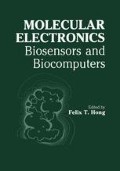Abstract
Scientists of diverse background have in recent years joined a new scientific adventure. Molecular computing, molecular and bioelectronics, biocomputing, biomolecular information processing, and biochip are some of the terms that have been used to describe this new direction. Another term is “molecular functional systems”.
Access this chapter
Tax calculation will be finalised at checkout
Purchases are for personal use only
Preview
Unable to display preview. Download preview PDF.
References
M. Conrad and F. T. Hong, Molecular computer design and biological information processing: an electrochemical and membrane reconstitution approach to the synthesis of a cellular automaton, in: “Proceedings of the International Symposium on Future Electron Devices-- Bioelectronic and Molecular Electronic Devices,” M. Aizawa, ed., pp. 89–94, Research and Development Association for Future Electron Devices, Tokyo (1985).
F. T. Hong, The bacteriorhodopsin model membrane system as a prototype molecular computing element, BioSvstems. 19:223 (1986).
E. A. Liberman, S. V. Minina, O. L. Mjakotina, N. E. Shklovsky-Kordy, and M. Conrad, Neuron generator potentials evoked by intracellular injection of cyclic nucleotides. Brain Research. 338:33 (1985).
S. R. Hameroff, “Ultimate Computing,” North Holland, New York (1987).
H. T. Tien, Ultrathin bilayer film: an experimental approach to biomolecular electronic devices, in: “Molecular Electronic Devices,” F. L. Carter, R. E. Siatkowski, and H. Wohltjen, eds., pp. 209–226, North- Holland, Amsterdam (1988).
M. Conrad, “On design principles for a molecular” computer, Comm. ACM. 28:464 (1985).
M. Conrad, The price of programmability, in: “The Universal Turing Machine: A Fifty Year Survey,” R. Herken, ed., pp. 285–307, Oxford and Verlag Kammerer & Unverzagt, Hamburg-Berlin (1988).
M. Conrad, Bootstrapping on the adaptive landscape, BioSystems. 11:167 (1979).
M. Conrad, “Adaptability,” Plenum Press, New York (1983).
M. Conrad, Algorithmic specification as a technique for computing with informal biological models, BioSvstems. 13:303 (1981).
M. M. Rizki and M. Conrad, EVOLVE III: A discrete events model of an evolutionary ecosystem, BioSvstems. 18:121 (1985).
H. Kuhn, Molecular engineering--a begin and an endeavor,: “Proceedings of the International Symposium on Future Electron Devices--Bioelectronic and Molecular Electronic Devices,” M. Aizawa, ed., pp. 1–6, Research and Development Association for Future Electron Devices, Tokyo (1985).
M. Conrad, Molecular computer design: a synthetic approach to brain theory, in: “Real Brains, Artificial Minds,” J. L. Casti and A. Karlqvist, eds., pp. 197–226, North-Holland, New York (1987).
M. Conrad, Quantum mechanics and molecular computing: mutual implications, Int. J. Quant. Chem., 15:287 (1988).
N. N. Vsevolodov and G. R. Ivanitskii, Biological light-sensitive complexes as technical information photocarriers, Biophysics. 30:962 (1985).
R. R. Birge, Photophysics of light transduction in rhodopsin and bacteriorhodopsin, Ann. Rev. Biophys. and Bioeng. 10:315 (1981).
R. I. Gilmanshin and P. I. Lazarev, Biotechnology as a source of materials for electronics, Biotekhnologiya. 3:421 (1987).
R. S. Potember, R. C. Hoffman, S. H. Kim, K. R. Speck and K. A. Stetyick, Molecular optical devices, J. Molec. Electronics. 4:5 (1988).
Author information
Authors and Affiliations
Editor information
Editors and Affiliations
Rights and permissions
Copyright information
© 1989 Plenum Press, New York
About this chapter
Cite this chapter
Conrad, M. (1989). Towards the Molecular Computer Factory. In: Hong, F.T. (eds) Molecular Electronics. Springer, Boston, MA. https://doi.org/10.1007/978-1-4615-7482-8_40
Download citation
DOI: https://doi.org/10.1007/978-1-4615-7482-8_40
Publisher Name: Springer, Boston, MA
Print ISBN: 978-1-4615-7484-2
Online ISBN: 978-1-4615-7482-8
eBook Packages: Springer Book Archive

